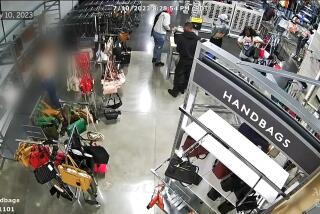Wal-Mart deal puts Dell where shoppers are
Of all the stores in the world, why did Dell go with Wal-Mart?
There are several reasons, and they make sense when you remember that Dell Inc. -- which pioneered selling computers and electronics directly to customers -- has lost share in the PC market for the last year.
It needs to get its products in front of as many potential buyers as possible as fast as possible, and Wal-Mart Stores Inc., with 127 million U.S. customers every week, seemed the best brick-and-mortar bet.
So starting June 10, two of Dell’s desktop PC models will go on sale in more than 3,000 Wal-Marts in the U.S. and Puerto Rico, Dell said Thursday. Until then, you can’t buy a Dell computer in any physical place in the country, though there is a Dell store in a Dallas mall and about 100 kiosks in other malls around the country, where you can take a PC or notebook for a test drive.
Wal-Mart offers several advantages, the most obvious being that “90% of America” shops there, as Dell spokesman Bob Pearson put it.
What’s more, computers from Hewlett-Packard Co., Dell’s chief rival, are already on Wal-Mart shelves, so people are used to buying PCs at the discount retailer. And for Dell, being in Wal-Mart could be a fast-paced learning experience.
“From a cultural standpoint, it will be a difficult transition” for Dell, said Stephen Baker, vice president of industry analysis at market research firm NPD Group in Port Washington, N.Y. “They are used to owning the customer experience.”
But teaming with a major retailer could boost Dell sales by as much as $800 million, or 14%, a year, Pacific Crest Securities said in a report issued this week.
NPD Group said that in the last year, 38.6% of all computers were bought directly from the manufacturer and 61% from stores.
“What we’re announcing is the beginning of a global retail strategy,” Dell’s Pearson said. “The direct model will continue to be a core for Dell. But we need more choice for customers.”
The two desktop PCs are from Dell’s low-end Dimension line. The company didn’t reveal details, but people familiar with the partnership said the computers would use Advanced Micro Devices Inc. chips and would cost $400 to $700. Wal-Mart said the Dell computers would also be available through Sam’s Club.com but not Walmart.com.
Partnering with Wal-Mart does pose risks for Dell, analysts said. Wal-Mart runs counter to the upscale image that Dell has been trying to project, and having its PCs in Wal-Mart could back Dell into a price-cutting battle it doesn’t want.
“You don’t want the Dell name and the Wal-Mart name to get too closely associated,” said J.P. Gownder, principal analyst at Forrester Research in Cambridge, Mass.
Dell seems to be hedging its bets by limiting its Wal-Mart exposure to the low-end PCs and excluding notebook computers, which are the hot sellers now.
“It’s a little bit of damage control,” said Shaw Wu, an analyst at San Francisco-based investment bank American Technology Research Inc.
Dell went the retail route in 1991 in stores such as CompUSA Inc., Best Buy Co. and Wal-Mart. In 1994, it pulled back and returned to direct sales.
On Thursday, Dell said that it wasn’t abandoning the direct-sales model but that the strategy was evolving.
Michael Dell, the company’s founder who in January returned to the chief executive post after relinquishing it in 2004, signaled that a change would be coming in an April memo to employees in which he said, “The direct model has been a revolution but is not a religion.”
Last fall, Dell slipped from being the No. 1 seller of PCs globally, losing the title to HP.
Dell shares fell 37 cents to $25.89.
More to Read
Inside the business of entertainment
The Wide Shot brings you news, analysis and insights on everything from streaming wars to production — and what it all means for the future.
You may occasionally receive promotional content from the Los Angeles Times.








